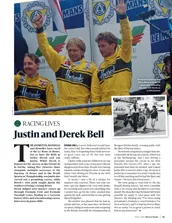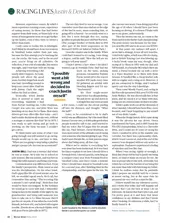“Well, they were good times and I won eight F3 races in my first season. These days I’d be straight into an F1 car, right? Well, we went to F2, and with 10 grand from the bank we bought a Brabham [BT23], two engines, a Transit van and a trailer. We had a workshop on the farm and Ray Wardell came as mechanic.” He pauses. “We did OK, came third in the first race at Thruxton behind Stewart and Beltoise, then fourth at Hockenheim until the clutch packed up. Not bad for privateers.”
That’s when the call came, via Keith Ballisat at Shell. He said Ferrari wanted to give him a test after the race at Crystal Palace. But Ickx crashed the car that weekend and it would be another two weeks before they called again.
“They wanted me to go to Monza and test the Formula 2 car there,” he recalls. “This was beyond a dream. I mean I was ploughing fields on the farm between races, dreaming that maybe one day I’d get to race one of the top cars. But never did I think I’d drive for Ferrari. There I was at Monza in the late morning and now it’s the big time. It was lonely somehow. I was used to my own mechanic being with me, and the Colonel [his stepfather, Bernard Hender] wasn’t there. But I remember so well the feeling of this bright red car, the smell of the upholstery, the buttons that hold the seat in the cockpit, the open-gate gearchange, the badge on the steering wheel.” He puts his thumbs and forefingers together, as if guiding that racing car with his trademark deft touch.
“I knew the track – I’d been there in F3 – and I drove as fast as I could. The engine wasn’t that good; not as good as Cosworth’s. You had to keep it really wound up. If you dropped the revs, there was no power and not enough torque. The Cosworth had more power low down. But I went for it and at the end of the day Signor Gozzi said: ‘We’d like you to race for us’. It was as though it was somehow pre-ordained.”
From here on, he says, it was a bit of a blur. Suddenly he was back in the rented Fiat and on the road to Modena.
“They put me in the Real Fini hotel just down from the factory. I’ve never enjoyed my own company much but I got on with it, ordered a meal and discovered this fantastic thing called tortellini. It was just so good – I’ll never forget it – and I wasn’t driving the next day so I sat in the bar and had a glass of wine with a girl who showed me a lot of leg.” Big grin. “Anyway, the following day I was due to meet Enzo Ferrari so I went to bed alone, wondering if I was on my
way to a grand prix drive.”

Bell’s second ’68 race at Moonza for Ferrari: the Italian Grand Prix
Grand Prix Photo
Meeting the Commendatore was not a disappointment. The events of the following day have not been experienced by the more recent employees of the scuderia.
“I was met by his secretary, a man in those days. It was said that Signora Ferrari was at best lukewarm on the idea of having girls in the Old Man’s office. It was weird, the whole place was deserted, the factory and the race shop entirely empty; silent. I was told that it was a national holiday. On a Wednesday? Turns out they were on strike which was not unusual in those days.
“We stood among the cars, all these gorgeous red Ferraris at shoulder-height on their production rigs. Suddenly the man himself walks around the corner, pale green raincoat draped over his shoulders; dark glasses and the perfect haircut – he’d just been to the barber. I was nervous,” smiles Derek. “I wasn’t that confident then, hadn’t been around much. A quick shake of the hand and we’re off to lunch at the Cavallino. He asked me if I rated Jochen Rindt. I said that yes, I did. We chatted via his interpreter and then it was time to go. No contract, but he wanted me to race for him: just unbelievable.”
Back home, Derek got back in the Brabham and had some good races. The contract came, not from Modena, but from Ballisat at Shell. He was to report for duty at Monza, for the famous Lotteria slip-streamer.
“Forghieri came over, andtold me that if I crashed then I would never drive a red car again.”
“People kept telling me that Ferrari killed its drivers. My wife was ill in hospital and my mother told me that if I signed for Ferrari then I’d never set foot in her house again. ‘Over my dead body will you race for them,’ she said. It was a stressful time.”
He did not sign the contract but took pole position at Monza, led the slip-streaming battle and the worries went away. But it all went wrong at the Parabolica. “It was two abreast all the way round – you know, typical Monza – and I came down a gear for the curve, floored it and lost it.
I don’t know what happened but there were cars everywhere. I think I was hit up the back. All the Ferraris were out. There was a fire and it was all on the TV back home. I was summoned to Modena by Gozzi who told me that the Old Man was so pleased with my pole that he was giving me $1000 in cash. So I signed the contract.”
At Zandvoort Derek took pole again, won his heat and lined up alongside Clay Regazzoni for the final. He was leading when Chris Lambert crashed and the race was stopped. “We didn’t know that Chris had died but the race was re-started and I retired when the gears jammed. It was always second to third, the lever jammed in the gate, but they told me I was shifting too fast. It was never the car and always the driver.”
Now it was time for the big one, the test in the F1 car at Maranello. Young Bell was on the verge of realising his dream.
“Yes, it was exciting. It was raining, which was alright with me. The muletta was wheeled out into the drizzle, on dry tyres. There weren’t any wets, just those grooved things. [Mauro] Forghieri came over, told me that if I crashed then I would never drive a red car again. Great, thanks! But rain never frightened me and out I went, fast as I dared, right on the limit. Two laps in, I noticed a 2+2 Ferrari parked on the grass at the first corner. The Old Man was sitting there, watching me.” He looks thoughtful. “What a day.”







